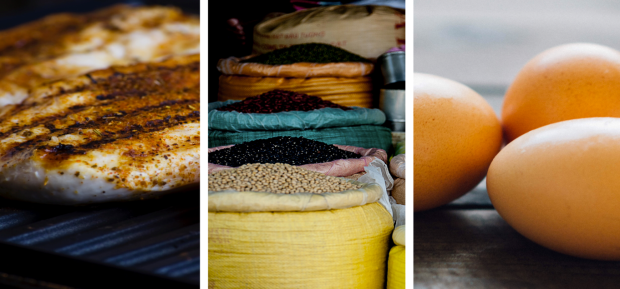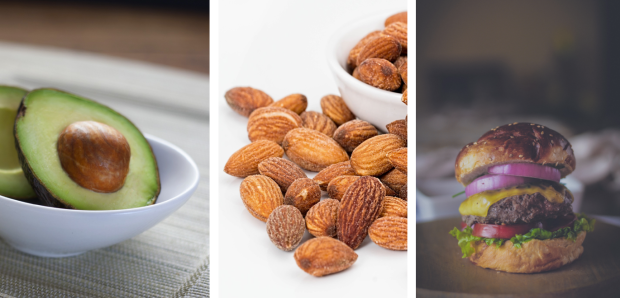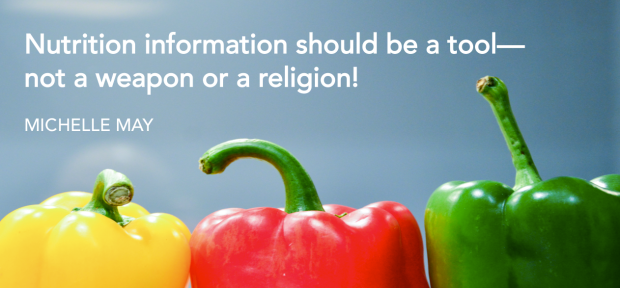Carbohydrates, protein and fat have all been in the spotlight over the years, either demonized and given the “health halo” depending on the time period. Let’s take a walk down memory lane: At one point, fats were demonized for their effects on heart health leading to the popularity of fat-free, sugar-filled Snackwells and arguably more health problems than people were having before. Years later, the Atkins Diet was promoting the weight loss benefits of a high-fat, high-protein, and low-carb diet, known for it’s unpleasant side effects during the “induction” phase: constipation, dizziness, headaches, weakness, and fatigue. More recently, rather than targeting one nutrient, diets like “If It Fits Your Macros” have people hyper-vigilant about the ratio of macronutrients that they eat.
While diets like these may be some scientific evidence backing these diets, the information is often misinterpreted or taken to an extreme by the time it gets to the media and general public. Also, regardless of any scientific evidence supporting these diets, if a diet isn’t practical or sustainable, is it really going to be beneficial to our health?
Our bodies are designed to break down and utilize all three macronutrients: carbs, protein and fats. In fact, the byproducts of carbs, protein, and fat metabolism are essential for our health and wellbeing. Despite all the nutrition noise around macros, the science behind carbs, protein and fats and how they are used in the body has not changed dramatically over the years. Understanding the importance of each macronutrient can help you feel more confident making food choices that keep you fueled, energized and satisfied. Without getting too deep into the biochemistry and physiology, let’s tackle are some of the basics on macros:
CARBOHYDRATES (CARBS)
What Are Carbohydrates?
From a chemistry standpoint, carbohydrates are made of carbon, hydrogen, and oxygen. Some carbs have a simpler chemical structure (simple carbohydrates), including sucrose in table sugar, lactose in milk products, and fructose in fruit and honey. Other carbs have a longer structure (complex carbs), like the carbs found in oats, barley, beans, and potatoes.
During digestion, almost all carbohydrates break down into glucose and are absorbed into the blood. However, simple carbs break down faster, causing blood glucose to rise and fall more quickly, especially if they aren’t paired with protein or fat. This can give you a burst of energy followed by what’s famously known as a “sugar crash.” While simple carbs get a bad rap, there are times when they may be just what you’re body needs. For example, right before going for a run, quick-fasting carbs like pretzels or gummies may be a better choice than oatmeal with berries and flax seeds (cue bloating and diarrhea).
Complex carbs, on the other hand, take longer for the body to convert to glucose so they generally give us more sustained energy and leave us feeling full longer. Fiber is a unique type of carbohydrate that adds bulk and fills you up without actually getting digested. This is why a simple carb with fiber (like a piece of fresh fruit) can be more filling than a simple carb without fiber (like soda).
How Are Carbs Used in the Body?
Once carbohydrates are broken down into glucose, their primary role is to give our cells energy. Here are some ways our bodies use glucose:
- Energy for Brain Power: Have you ever had a foggy brain or had trouble concentrating after going a while without eating carbs? Our brains need about 120 grams of glucose/day!
- Energy for Muscles: Our muscles store glucose in the form of glycogen so that we can break it down when we’re active, exercising, and in need of energy. Like fueling a car with gas, without carbs to fuel our bodies, we are running on empty.
- Energy for Body Proteins: Many of our cells, like blood cells, skin cells and nerve cells, need energy from glucose to do their job.
- Storage as Fat: If we take in more energy from food than our body needs, overtime the the extra energy from carbs get stored as fat in adipose tissue. More on this in the fat section.
How Much Do We Need?
Though we can survive off of fat and protein for energy for a while, carbohydrates are the body’s preferred source of fuel. The general recommendation is to have 45 to 65% of our daily energy intake is from carbohydrate, according to the Institute of Medicine’s Acceptable Macronutrient Distribution Range (AMDR). There is a range because the amount of carbs that our bodies need depends on many factors like genetics, age, gender, activity level, lifestyle, and medical conditions. A long-distance runner may need a higher percentage of carbs in their diet than someone of the same age with a less active lifestyle. That being said, going to either extreme, eating too much or too little carbs, can take a toll on our bodies.
More than the amount of carbs, the type of carbs that we eat is just as important to consider. When you’re looking for long-lasting energy or something to hold you over for a few hours, the complex carbs and fiber carbs from whole grains, beans, legumes, vegetables, and fruits are usually a smart choice. On the other hand, low-fiber simple carbs like juice, crackers, cookies, and white pasta can come in handy when you need quick energy. This is why juice or soda can treat hypoglycemia in someone with type 1 diabetes. This also the reason why eating crackers with cheese or cookies with milk is not only delicious, but also a helpful way to keep blood sugar stabilized.

PROTEIN
What is a Protein?
Amino acids are the building blocks of protein, made of carbon, hydrogen, oxygen, and nitrogen atoms. Each amino acid has a unique side structure, making proteins more complex and diverse than carbs and fat. Among the 20 different amino acids, nine are essential: histidine, isoleucine, leucine, lysine, methionine, phenylalanine, threonine, tryptophan, and valine. These nine amino acids are essential to get from food since the body cannot create them itself. The other amino acids are either non-essential, meaning our bodies can make enough of them so we do not need them from food, or conditionally essential, meaning they become essential only under during certain circumstances (i.e. metabolic disorders, heart disease, or serious infections).
Why does it matter? Not all protein foods have all nine essential amino acids, which is why some protein foods are considered incomplete proteins (low quality) and others are complete proteins (high quality). Foods from animals (meat, fish, cheese, eggs, milk) are complete proteins, while most foods from plants (nuts, seeds, beans) are incomplete because they have one or more essential amino acid is missing. The concept of complementary proteins, combining plant proteins at meals to provide all essential amino acids, was recommended for vegans and vegetarians to meet their amino acid needs in the past. However, we now know vegans and vegetarians can get all their essential amino acids by eating a variety of plant-based proteins over the course of the day, rather than focusing on combining plant proteins at specific meals.
How Are Proteins Used in the Body?
After protein is digested, the amino acids travel into the blood throughout the body where they are used to make over 30,000 different kinds of proteins. The wide variability in the structure of proteins is what makes them so important and versatile, involved in every cell of the body. Here are a few of the ways our bodies utilize amino acids from protein foods:
- Growth and Tissue Repair: Skin, nails, hair, muscles, organs and bone are all made of proteins. Getting enough protein helps them to maintain their structure and regenerate when needed.
- Enzymes and hormones: Enzymes are one type of protein that are essential for many metabolic processes like digestion. Proteins are also used to make hormones, which act as messengers to regulate different bodily processes like acid-base balance, fluid balance, and metabolism.
- Transportation: Protein’s unique structure makes it optimal to carry different nutrients throughout the body, into and out of cells. For example, hemoglobin is a protein that carries oxygen in the blood from the lungs to our cells. As a “pump,” transport proteins also help electrolytes to pass through cells, which is critical for muscle contractions and nerve transmissions.
- Antibodies: Antibodies are proteins that support immune health, protecting us against foreign invaders like the flu, smallpox, and the measles.
- Energy: When we eat less calories than our body needs and we’ve emptied our carb stores, our bodies dig into protein stores in the liver and muscle to make more glucose, leading to muscle wasting. Considering we want to preserve our lean body mass (muscle), extremely restricting calories in an attempt to lose weight can do more harm than good for our bodies.
How Much Do We Need?
Most of us get plenty of protein in our diets, even vegetarians and vegans. The AMDR recommendation for protein is 10 to 35% of daily calorie intake. Like carbohydrates, protein needs also vary depending on someone’s age, stage of growth, body composition, lifestyle, and physical activity. For example, a pregnant woman needs proportionately more calories from protein to support a baby’s growth and development. Vegans and vegetarians may also need a greater percentage calories from protein in their diet if their food sources are low quality or incomplete proteins.
The timing of protein may actually be more important than your total daily intake. Since our bodies can only utilize about 20 to 35 grams of protein for protein synthesis at one time, distributing protein throughout the day is best. For example, someone may aim for 15 to 30 grams of protein at three meals and at least one snack. Eating protein from a variety of foods will also ensure you’re getting enough of all nine essential amino acids.

FAT
What Are Fats?
Fats are made of long chains of carbon atoms, varying in length and type of bonds. Unsaturated fats have at least one double bond on the carbon chain, while saturated fats only have single bonds between carbon atoms. Unsaturated fats are found in foods like nuts, seeds, avocados, and oils (olive, canola, peanut), and fatty fish. Saturated fats are found in coconut oil, butter, cheese, ice-cream, and fatty cuts of meat (bacon, sausage, burgers). Trans fats are in another category. Unlike unsaturated and saturated fats, most trans fats are man-made, created through hydrogenation which turns vegetables oils into solids and increases shelf-life. However, trans fats are no longer Generally Recognized as Safe by the Food and Drug Administration and will be banned from our food supply due to the negative health effects associated with them in research. Some foods that commonly had trans fats are baked goods (cakes, pies, cookies, biscuits), fried foods (doughnuts, fast food), margarine, frostings, and some snack foods.
How Are Fats Used in the Body?
Believe it or not, fat does have a purpose in the body, beyond being a storage site. Here are a few of the important roles of fat:
- Protection and Insulation: Our bodies are meant to have a certain percentage of fat —fat acts as a cushion to protect our bones and organs. Fat also helps regulate body temperature by giving us a layer of insulation under our skin.
- Brain Signaling: Myelin sheath, made of mostly unsaturated fats, is essential for our brain to receive signals to and from the rest of our body. Without myelin to aid neural communication, our heart rate, breathing, and digestion cannot be carefully regulated.
- Hormones: While some hormones are made from proteins, others are made from lipids, like estrogen, testosterone, and cortisol. For this reason, without enough body fat, the body’s estrogen levels can run low, which could lead to negative side effects like bone loss and amenorrhea in women.
- Vitamin Absorption: Vitamins A, D, E, and K are fat-soluble vitamins. If we don’t eat enough fat in our diet, or do not have enough fat stores, then these vitamins cannot be absorbed or utilized efficiently in the body.
- Energy or Storage: When the body is deprived of calories and glycogen stores are empty, stored fat is broken down, along with muscle protein, to meet our energy needs. On the other hand, when we are in positive energy balance, excess calories from fat is stored in adipose tissue. Though our bodies need fat to survive (as you can see from the list above), having too much fat stored, especially around the belly, can increase risk of developing type 2 diabetes and heart disease. Researchers suggest adipose tissue can act as endocrine organ, releasing hormones involved in insulin resistance and inflammatory diseases.
How Much Do We Need?
The AMDR for fat is 20 to 35% of our daily calorie intake, according to the Institute of Medicine. With 9 calories per gram of fat (compared to 4 calories per gram of carbs and protein), most of us get plenty fat in our diet to meet our needs. However, the type of fat in most Americans’ diets is often disproportionate. We tend to get too much trans fat, which is linked to heart disease, stroke, and type 2 diabetes, and saturated fat, which most research suggests also have negative impact on our overall health.
The fats we tend to not get enough of (yet are the most beneficial) are unsaturated fats, especially omega-3 fatty acids found in salmon, mackerel, sardines, flax seeds, walnuts, and canola oil. These unsaturated fats counteract the effects of trans fat, reducing inflammation and promoting heart health. Generally speaking, aim for more unsaturated fats, less saturated fats, and minimal trans fats.

Still with me? Hopefully this gives you a better understanding of how different types of carbohydrates, proteins, and fats impact your hunger, energy level, and overall health. There is no single optimal ratio of macronutrients, which is why both the Mediterranean diet (higher in fat, lower in carbs) and the DASH diet (lower in fat, higher in carbs) are considered beneficial for overall health. Rather than focusing on a certain number of grams or a ratio of your macros, use these nutrition basics to find a healthy balance of carbs, protein, and fat that keeps you fueled and nourished.


Love this! So informative
LikeLike
Love the blog Katelyn! Thanks for taking so much of the confusion out of nutrition facts
LikeLike